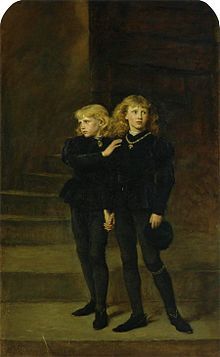Bishop Stillington: A key role or a bit player?

Robert Stillington was Dean of St. Martin le Grande (a church where he later sought sanctuary) and became, briefly, under Henry VI, Keeper of the Privy Seal, a role he continued in under Edward IV. In 1466, he was consecrated as Bishop of Bath and Wells, and the following year he was promoted to Lord Chancellor, a post he held (with a short break) until his resignation in 1473. In ’75 he accompanied the king on his expedition to France and that same year was summoned to Rome to answer charges, the nature of which I’ve been unable to discover. Possibly he had been neglecting his pastoral duties in favor of his secular ones.
In 1478 he was sent to the Tower of London. Some have speculated that whilst there he mumbled a certain secret to the Duke of Clarence, and that was the real reason Clarence was put to death – and nothing whatever to do with the multiplicity of treason charges against him. Oh, right, and after killing his brother Edward let the bishop go to spread such potentially dynasty-destroying information far and wide!
A less popular theory is that Clarence whispered the secret to Stillington. Neither one can possibly have happened because Stillington didn’t arrive at the Tower until a few days after Clarence had been carried out of his bier. (Stonor letters II-42) Well then, perhaps the secret was passed between them before either one saw the inside of the Tower as a prisoner. This is even more unlikely. If Clarence had been in possession of such information he would have used it to defame and damage his brother or I do not know my Clarence.
Why was Stillington imprisoned? According to his pardon he was accused of violating his oath of fidelity by speaking out against the king, but upon being examined before the king and certain lords ecclesiastical and temporal he was able to prove his innocence and released after a few weeks. Gairdner (Richard III 90) would have us believe that he had offended King Edward by trying to persuade him to make amends to Lady Eleanor Talbot/Butler, to whom the king had once proposed marriage in Stillington’s presence. Consider that Edward had been married for fully fourteen years and Lady Eleanor in her grave for fully ten years, so no amount of amends was going to do her any good, and you can’t help wondering why the good bishop waited to long to raise the issue.
However, no one is terribly interested in the bishop’s early years. It is only in 1483 that he becomes of real interest, because then, so we are told ad nauseum, he placed evidence before Richard of Gloucester that proved King Edward – then recently deceased and unable to defend himself – had been precontracted to the aforementioned Lady Eleanor, a daughter of the Earl of Shrewsbury; therefore it followed that King Edward and Queen Elizabeth lived together ‘sinfully and damnably’ and the issue were bastards and could not inherit the throne. Evidence! I hear/read the word all over and yet when I ask simple questions like: What was the evidence? What did it consist of? When was it given? I am deafened by silence.
According to Alison Weir, the first account we have concerning Bishop Stillington and the precontract comes from Philippe de Commines, a French chronicler, who did not begin writing his memoirs until 10 years after the relevant events. Amazing! Ten years of silence from the English chroniclers, letter writers, official records etc! Commines writes that on June 8th Stillington appeared before the council and revealed that King Edward had promised marriage to Lady Eleanor on condition that he might lie with her. The lady had assented and the bishop performed the ceremony with only himself and the two principals present. Commines also states that the bishop produced written evidence and witness depositions to prove his contention.
Nothing is documented to show Stillington appeared before the council on this day. If he had, and revealed such shocking news, wouldn’t it have leaked? Wouldn’t London have been agog? Wouldn’t someone have mentioned it in a letter or a chronicle?
On June 22nd, at the public pulpit outside St. Paul’s Cathedral, Dr. Ralph Shaa, along with other preachers in diverse places, revealed the sordid machinations of Richard of Gloucester’s brother and called for the disinheriting of his children. Leaving no stone unturned, they also repeated the old story about Edward himself being a bastard, which wasn’t a very nice thing to say about his mother who was still alive. Nothing was said on this occasion about Lady Eleanor or Stillington.
On June 24th the claim was repeated before the mayor and aldermen and the following day to an assembly of lords and clerics. (Parliament had been summoned for June 26th but then had been cancelled by writ. Some of the members had already arrived in London and some were on their way and decided to continue and stay on. Some had arrived for the coronation. This random group in no way constituted a parliament). On these occasions the scurrilous accusations about the Duchess of York had been dropped, never to be revived. Neither Eleanor Talbot nor Bishop Stillington were mentioned.
Nevertheless, it was this body that declared Edward V deposed and Richard of Gloucester the true claimant. Many of them accompanied Buckingham to Baynard’s Castle, along with the mayor and aldermen and some of the chief citizens, all eager to curry favor with the one in power and anxious to avoid the fate that had befallen Hastings only twelve days earlier. Richard, offered the crown, modestly declined the honor, and only accepted when Buckingham declared if he refused they would have to seek their king elsewhere.
In January of 1484, when the young sons of Edward IV had not been seen for several months, the first and only parliament of Richard III’s reign was held. A petition was presented called Titulus Regius, in which the king that laid out his justification for the seizure of his nephew’s throne. Fully six months after the coronation, during which time he and his advisers had had ample opportunity to do a thorough investigation and prepare their evidence. They had come up with five specious reasons, the precontract being the last. On this occasion a name was given to the poor lady Edward IV had allegedly deceived and debauched: Lady Eleanor Talbot. But no mention was made of Bishop Stillington; no evidence was presented. How distinctly odd!
My conclusion is that Stillington was a bit player, on the sidelines until he stepped forth in parliament and presented the petition, Titulus Regius. Yes, that much he did. And perhaps that’s why Philippe de Commines associated him with the precontract. Perhaps Titulus Regius is the written document to which Commines refers.
So, when next you read that Stillington’s evidence did not survive, I ask you to remember this: there never was any!
Other sources:
Dominic Mancini
The Croyland Chronicle
Charles Ross: Richard III
Wikipedia





